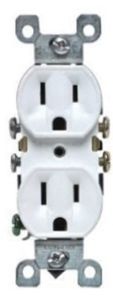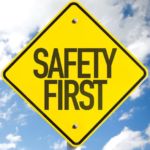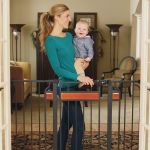
Electricity has become a popular source of energy to power various electrical devices around the house. Without electricity we would struggle to get by our daily routines, yet becoming an informed and active consumer of life saving tips can help keep yourself and family safe.
In the U.S. there are several electrical related injuries and deaths due to improper electrical installations and also due to lack of preventive measures to secure adults, babies, and children from electrical shock.
There are about 2,200 injuries and about 400 deaths each year related to electrical fires. Electrical shock is one concern to protect babies and children at home, but you must also prevent electrical fires.
Most electrical fires can be prevented by taking the appropriate measures to secure your home.
Some of the common electrical safety tips include:
- Any outlets near water should be ground fault circuit interrupters (GFCIs).
- Never place extensions cords under a rug since increase risk of electrical fire.
- Should find and correct any overloaded circuits (you may need to hire an electrician).
The National Fire Protection Association (NFPA) also has recommends the following electrical safety tips:
- Don’t overload outlets. Only plug one high-wattage appliance into outlet at a time.
- GFCIs should be installed in the kitchen, bathrooms, laundry rooms, basements, and any outdoor outlets.
- Replace any damaged or loose electrical cords.
- A home with babies or young children should have tamper-resistant (TR) receptacles.
- Make sure to check manufacturer’s instructions for plugging appliances in outlets.
Now that we have discussed some basic tips and information about the risks of electrical injury we will start to take preventive measures to protect babies and children at home.
The Basics to Baby Proofing Electrical Outlets at Home
First you will need to become familiar with the types of outlets you have at home. In the U.S there is the regular standard electrical receptacle, which are usually found in most houses built before 2008.
There are also tamper resistant receptacles, which most often be in houses built after 2008 and will have the letters “TR” engraved on the outlet.
Also be aware that there are two styles of electrical outlets. At home you may find you have:
Standard electrical outlets or/and Decora electrical outlets. The main difference between the two is the standard style has a screw in between the two outlets. The majority of GFCI outlets will be Decora style.
Why do you need to know which type of receptacles and outlet styles you have at home?
To make sure you don’t waste time returning baby proof items because it does not match your specific outlet style or type.
Easy Way to Baby Proof Empty Electrical Outlets
Electrical Outlet Plugs
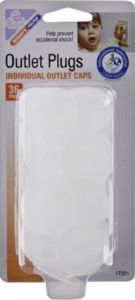
Will fit Decora style outlets, but designed for standard style outlets.
Will my toddler be able to remove these electrical outlet plugs?
For the majority of the standard style outlets the plugs should fit tightly. Adults may need to use finger nails or prong on side of plug to pull out cap from outlet.
Electrical Outlet Covers
Note: You will need to remove existing outlet cover and replace it with a baby proof cover. The majority of electrical outlet covers are spring loaded which prevent baby or child from poking inside the outlet.
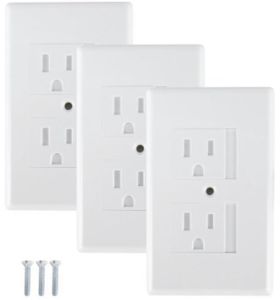
For use with standard style outlets.
Will these electrical outlet covers work for a 3 year old toddler?
Yes, a toddler may be able to pull out a plug from the outlet, but will not be able put fingers into the outlet. Connecting a plug requires a sideways slide motion, which close automatically, to gain access to electrical outlet.
For both Decora and standard outlets.
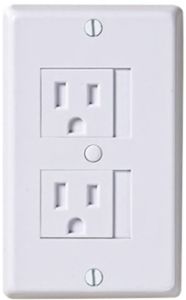
What are the dimensions of these outlet safety plates?
The dimensions are 2.75 width by 4.5 height by .25 depth inches.
Easy Way to Stop Child from Unplugging Cords.
Moving furniture around the house may be the fastest way to prevent child from unplugging cords.
Sometimes, it may be a hassle to move furniture at home, so you may want to invest in electrical outlet covers that are placed on top of outlets with cords plugged in.
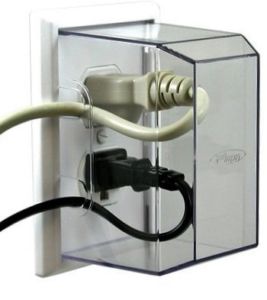
What is the age range for these outlet covers?
The recommended age is for children up to 4 years old, but may work for older children. Product requires knowledge of latching and to open requires adult strength.
Note: These safety products stand out from the wall about 3 inches.
Baby Proofing Power Strips
Power strips may be convenient in certain areas of your home such as where you have your computer or television. Baby proof power strips to avoid and prevent any electrical injuries.
Why some extensions cords need to be child proof?
Extension cords with unused outlets can be an electrical shock risk for babies and children, especially if they start to poke the outlets.
When babies start teething they may grab extension cords putting them at risk for electric shock.
Will this power strip cover keep my child away from extension cord?
The product is intended to restrict access to the plug areas as much as possible, but it does not cover the strip entirely.
May want to tape over the openings of the product so child does not try to insert things inside.

